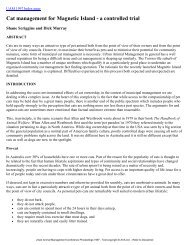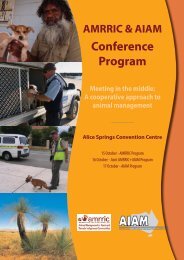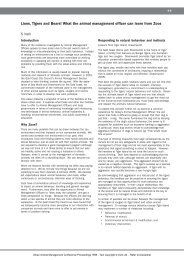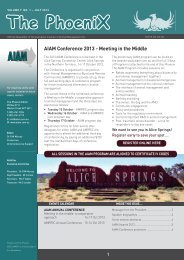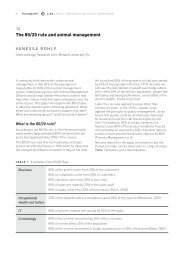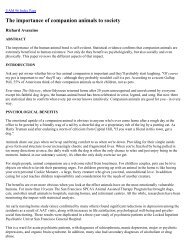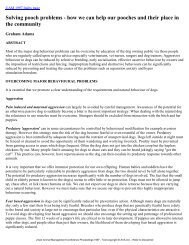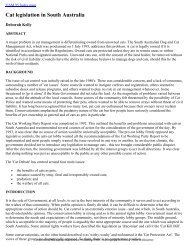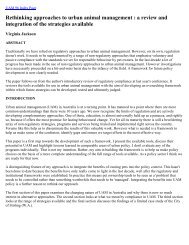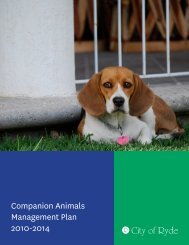Proceedings OF ThE - Australian Institute of Animal Management Inc
Proceedings OF ThE - Australian Institute of Animal Management Inc
Proceedings OF ThE - Australian Institute of Animal Management Inc
Create successful ePaper yourself
Turn your PDF publications into a flip-book with our unique Google optimized e-Paper software.
78 <strong>Proceedings</strong> 2012<br />
AIAM Annual Conference on <strong>Animal</strong> <strong>Management</strong><br />
• ythe model being designed on existing service<br />
levels;<br />
• ythe financial forecasting period; and<br />
• ythe level <strong>of</strong> community consultation… etc<br />
7. Scope<br />
Scope statements may take many forms and should<br />
capture, in very broad terms, the product <strong>of</strong> the<br />
project, for example, “developing a 10 year Strategic<br />
<strong>Animal</strong> <strong>Management</strong> Plan that describes the future<br />
aspirations, goals, strategies and key action plans for<br />
the management <strong>of</strong> companion animals kept in the local<br />
government area”.<br />
8. Strategic overview<br />
The strategic overview <strong>of</strong> the plan will include the<br />
vision, mission, core values and the overall objective<br />
sought from the plan.<br />
9. Vision statement<br />
During the community engagement process, it<br />
is vital for residents to develop a vision for their<br />
community and their Strategic <strong>Animal</strong> <strong>Management</strong><br />
Plan. However, the one non negotiable is the vision,<br />
must link to Council’s Community and Corporate<br />
Plans. For example, the Sunshine Coast Council’s<br />
Community Plan, proposes that the region be the<br />
most sustainable in Australia and the Corporate<br />
Plan compliments this statement by proposing that<br />
the Sunshine Coast be Australia’s most sustainable<br />
region, vibrant, green, and diverse.<br />
It therefore follows logically that the vision for the<br />
Strategic <strong>Animal</strong> <strong>Management</strong> Plan must not only<br />
compliment both the key strategic documents;<br />
it must also be aspirational and above all else<br />
achievable. The vision should not be a broad<br />
“motherhood statement” descriptor that doesn’t<br />
specify enough detail <strong>of</strong> how the future <strong>of</strong> the region<br />
will look.<br />
A vision can be represented in several ways, but a<br />
worded statement, describing the preferred future<br />
situation for the region will suffice.<br />
necessary to assist Council in becoming Australia’s<br />
most sustainable, vibrant, green and diverse region.<br />
The themes included:<br />
• ya robust economy;<br />
• yecological sustainability;<br />
• yinnovation and creativity;<br />
• yhealth and well being;<br />
• ysocial cohesion;<br />
• yaccessibility and connectedness;<br />
• ymanaging growth; and<br />
• ygreat governance.<br />
Each theme (once identified) attracted a number <strong>of</strong><br />
emerging priorities that are supported by a series <strong>of</strong><br />
strategies to which operational plans, projects and<br />
activities are scheduled.<br />
Table 3 below, provides an example <strong>of</strong> the hierarchy<br />
<strong>of</strong> Corporate Documents that will need to be<br />
considered in the preparation <strong>of</strong> an Strategic <strong>Animal</strong><br />
<strong>Management</strong> Plan and how the themes, priorities,<br />
strategies, actions and outcomes surface.<br />
For the purpose <strong>of</strong> better understanding the process,<br />
Table 3 below has identified via the Community<br />
Plan Region Growth as its theme. The Corporate<br />
Plan in response identifies planning for healthy and<br />
sustainable communities as a priority outcome.<br />
The key strategic issue follow and there could be<br />
several. In the example provided “infrastructure and<br />
asset management” are identified as the strategy.<br />
The Operational Plan subsequently presents an<br />
opportunity to review the current infrastructure<br />
and assets used by the business. The Business<br />
Plan however provides the challenge <strong>of</strong> preparing<br />
a long term fiscal management plan to ensure<br />
infrastructure and assets meet the growing needs<br />
<strong>of</strong> the community with consideration given to<br />
achievability <strong>of</strong> expectations.<br />
Table 3<br />
Document<br />
Theme/Priority/Strategy/Action/<br />
Outcome<br />
10. oPPortunities and CHAllenges<br />
To ensure that the vision <strong>of</strong> the Strategic <strong>Animal</strong><br />
<strong>Management</strong> Plan is cohesive with the Community<br />
and Corporate Plans, it is important to regularly<br />
revisit the documents to ensure that the linkages<br />
are there and they are transparent for all to see.<br />
This process will assist in identifying the challenges<br />
that Council and the community face and the<br />
opportunities that can be pursued under the plan.<br />
As an example, the Sunshine Coast Council<br />
Corporate Plan 2009-2014, identified a number<br />
<strong>of</strong> themes that the organisation believed were<br />
Community<br />
Plan<br />
Corporate<br />
Plan<br />
Strategic<br />
<strong>Animal</strong> Mgt<br />
Plan<br />
Operational<br />
Plan<br />
Business<br />
Plan<br />
e.g. Regional Growth (Theme)<br />
e.g. Planning for Healthy and Sustainable<br />
Communities (Priority)<br />
e.g. Infrastructure and Asset<br />
<strong>Management</strong> (Strategy)<br />
e.g. Review infrastructure and assets to<br />
determine future needs.(Action)<br />
e.g. Prepare a long term financial plan<br />
to meet infrastructure and assets<br />
requirements (Outcome)



